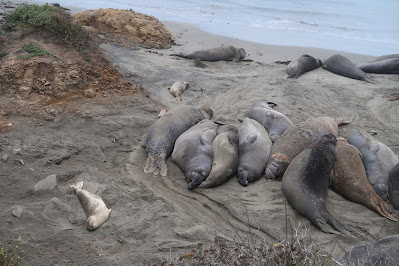Bulls and young of the year rest on the sand
Young seals are arriving on the beach for the fall Haul-Out. They join the mature bulls who are completing their annual molt. It’s a beach of contrasts.
A flock of Heermann’s gulls joined the seals on the
south beach. These gulls nest in Mexico, but migrate north during the
non-breeding season. They are easy to identify, with their dark gray plumage
and red bills. The elephant seals are the main attraction at the viewpoint, but
keep your eyes out for other wildlife.
Juvenile seals
The smallest seals are my heroes on the beach. They
are last winter’s pups, the Young of the Year. Any pup that survives that first
migration, begun last spring, has passed a major hurdle on the way to
adulthood. Only about half survive, so they may be small, but they are winners
in the test of survival. Their skin is perfect, smooth and unscarred.
Moving up in size are older seals. Not yet mature, but
getting there. Males are more common among the juveniles, because males take
longer to reach maturity, at age eight. Females may be mature and pregnant as
early as two years old, most by age four.
Young males and females look very much alike. Around
age five, males begin growing that nose, and get bigger than females.
They are the early arrivals for the Fall Haul-Out, six
weeks or so of rest in September through November. They are synchronizing their
timing with the rest of the seals, returning to the beach at predictable
seasons.
Migration
Heather Liwanag and her Team Ellie at Cal Poly tagged
10 weaned pups last spring, at the Vandenberg and San Nicolas, in the Channel
Islands, colonies. The satellite tags allow the team, and the public, to see
where they go. Satellite
Tags 2023 — VIP Lab (calpoly-viplab.com)
The
young seals know to head generally north, along the same routes the rest of the
seals take. Most didn’t go as far as mature seals, but one, Monarch, swam to
the Gulf of Alaska, a 4,000-mile trip.
Fox
stayed closer to his home beach, within a couple of hundred miles of his
Channel Island rookery.
They are diving and feeding almost constantly, more
than 20 hours a day. Satellite signals transmit only when the seal surfaces to
take a breath.
Roxanne Beltran and her team at the University of
California Santa Cruz are tracking first year and older seals. Check out their
journeys at Beltran
Lab – Ecology & Evolutionary Biology, University of California Santa Cruz
(ucsc.edu).
One seven-year-old female departed in June on her second
trip 3,452 miles west. She went to the same location, the Hawaiian-Emperor Seamount
chain, two years ago.
Constantly diving as she moves forward, she has
covered about 50 horizontal miles a day. By mid-August, the journey has taken
her ten weeks.
She hasn’t set a record – yet. That’s held by Phyllis,
who swam nearly to Japan, 7,400 miles, in 2017. The
mighty Phyllis returns after record-shattering swim (ucsc.edu)
Juvenile seals arrive and depart individually, on their own schedules. Young seals will be on the beach through the end of November, and perhaps beyond.
Bigger is bigger
The mature bulls are mostly done with their annual
molt, last year’s skin peeling off to expose new skin underneath. Compare the
size of the nose, the proboscis, to compare age. The proboscis continues to
grow throughout a seal’s life, so bigger is older.
This big bull's chest shield is bright pink as the skin on it molts and peels away. He's taking no lip from a younger bull. (Christine Heinrichs photo)
Although no adult females are on the beach for them to
fight over, the bulls have been entertaining visitors with loud calling and
bad-tempered sparring among themselves. Mostly they sleep.
Every day more bulls leave the beach, returning to the
ocean to continue bulking up in anticipation of the breeding season. That will
be their next appearance on the beach, in November and December. They arrive
before the pregnant females, who begin to arrive in December.
They’ll need all the blubber they can gain. They may
go without food for as long as 120 days as they battle for dominance and
breeding rights then.


